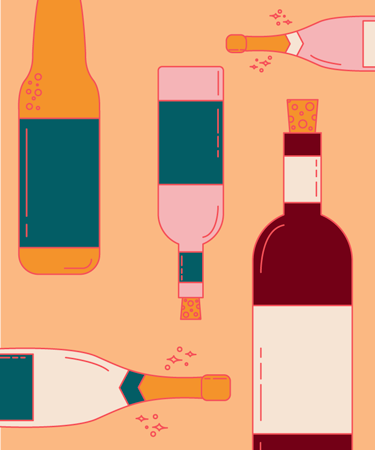
Another year, another set of New Year’s resolutions (also known as a set of promises that we’ll vehemently make on January 1, only to be forgotten before February rolls around). Atop most of these lists is the annual vow to lose weight, which usually coincides with the immediate nixing of any and all booze. It’s just too caloric, right? But maybe it’s this complete 180-degree shift that sets New Year’s resolutions up for failure. Rather than going cold turkey, why not instead ease into 2017 with some low-calorie, resolution-friendly wines?
No, we’re not talking about gimmicky Skinnygirl or Slim wine nonsense; with a little research, plenty of low-calorie bottles can be found on the shelf of the local wine shop. The two things that contribute significant calories to an alcoholic beverage are sugar and alcohol. Therefore, dry wines are going to be lower in calories than those with residual sugar, and lower-alcohol wines are lower in calories than higher-ABV bottles. This is also why wine can be more diet-friendly than liquor-based drinks; while the serving size is larger (yes, size does matter!), wine is lower in alcohol than liquor, and most cocktails require mixers that add calories as well. As a broad guideline, seek out bottles that are completely dry (most wines are) and contain 12 percent ABV or less. Regardless of the type of wine, no option is calorie-free, so moderation is key.
For those who have an extra bottle or two of bubbly left over from New Year’s Eve celebrations: great news! In general, sparkling wine is the lowest-calorie option of the bunch. It typically is lower in alcohol, as sparkling wines tend to be produced in cooler climates, and cooler climates tend toward lower-alcohol wines. Plus, most bottles contain a sweetness level “code” right on the label. Lower dosage equals lower added sugar, so anything labeled “brut nature,” “brut zero,” or “extra brut” is sure to be bone dry. A five-ounce serving of dry sparkling wine hovers right around 100 calories.
White wine lovers can also rejoice, as this is the second-best option for resolution-friendly wine. White wines tend to be lower in alcohol than reds, and many of those from the Old World fall into the 12 percent ABV-and-under category. Residual sugar is something to watch for with white wines, though; many single-digit ABV bottles have a significant amount of residual sugar, which isn’t ideal, as sweet wines on average have about 30 more calories per serving than their dry counterparts. Again, most wines are completely dry, but certain grapes can range along the spectrum from dry to sweet, such as Riesling, Chenin Blanc, Muscat/Moscato, and Pinot Gris. Some countries – Germany, for instance – will clearly label dry wines with words like “trocken,” but when in doubt, ask.
Does this mean that red wine drinkers need to change their taste preferences altogether? Of course not. While red wines tend to be fuller-bodied and therefore higher in alcohol than white and sparkling wines, there are absolutely some waistline-friendly options. Look for bottles that are 13 percent ABV and under; cooler climates in the Old World are the best sources for these bottles. The one positive about choosing red is there’s much less concern about sugar; nearly all red wines are dry. Fans of heavy reds may have to forgo their Malbecs and Merlots in favor of lighter options, but this small sacrifice is better than no wine at all, right?
Could 2017 possibly be the year in which we make our resolutions and actually keep them, too? Only time will tell, but until then, at least we can drink some responsible – and delicious – new wines.
Resolution-friendly wine cheat sheet
Sparkling
Champagne: One can never have enough Champagne, right? Because this most classic of sparkling wine regions is right at the climactic limit of where grapes can ripen, alcohol levels are almost always low, which means you may be able to squeeze in a second glass!
Crémant: A more budget-friendly little brother to Champagne, crémant wines are made in the traditional method in several other major regions of France, offering Champagne-like richness at a post-holiday price. Crémant de Bourgogne and Crémant de Jura are favorites.
Cava: Spain’s cool northeastern region produces sparkling wine in the traditional method, making bubbly that has complexity but is still super affordable.
White
Muscadet: Light, bright, and clean, this mouthwatering wine from the Loire Valley takes the guesswork out of selecting a bottle. By law, Muscadet must have a maximum ABV of 12 percent and no more than five grams per liter of residual sugar.
Picpoul: Found mostly in the southern Rhône and Languedoc regions, Picpoul is known for being crisp and zippy. Because it’s grown in warmer areas, the alcohol can sometimes be higher than it seems, but a bottle around 12 to 12.5 percent ABV is a great go-to.
Dry Riesling: Emphasis on dry. Riesling is one of those tricky grapes that may have very low alcohol combined with a lot of sugar! Look for German bottles labeled trocken or kabinett, or options from Eden and Clare Valleys in Australia, which may be slightly higher in alcohol but are guaranteed to be bone-dry.
Red
Barbera: Red-fruited, medium-bodied, and thirst-quenching, Barbera is often overshadowed by its more famous neighbor in Italy’s cool region of Piedmont: Nebbiolo. Leave the big ABV (and big price tag) bottles behind and take advantage of this everyday, easy-drinking grape.
Gamay: From regional level to cru, Beaujolais’ Gamay wines are always safe bets for delicious, quaffable reds that land around 12.5 percent alcohol. Best of all, with popularity surging, there are countless options to explore.
Schiava: This indigenous grape is almost solely grown in its home region of Alto Adige in northern Italy, but it’s worth seeking out; almost rosé-colored, Schiava produces light wines with balanced fruit and earth.
Pinot Noir can work, too, but check that alcohol percentage; depending on where it’s grown, Pinot Noir can reach alcohol levels of 15 percent!
